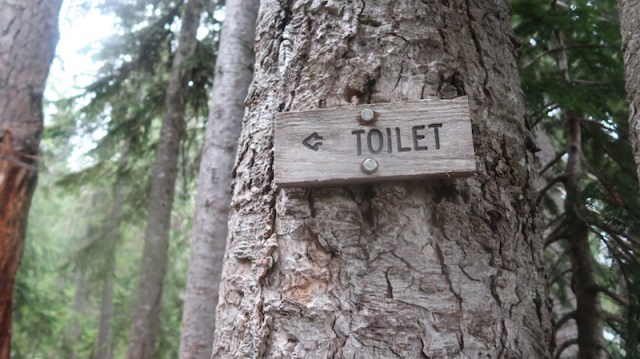
Everyone poops and anyone who has gone on an overnight backpacking trip has probably even pooped outside. For those of you who spend a considerable amount of time outside hiking or backpacking, you’re probably (and hopefully) aware of the rules for how to poop responsibly outdoors. If you aren’t, this blog post is for you. Even if you do know the poop rules, this post is still for you. Consider this information a refresher.
I’ve hiked over 2,400 miles of the Pacific Crest Trail and have done a fair amount of day hiking around the state of Washington, but that doesn’t make me a perfect hiker. No one is. There’s no such thing as a perfect hiker. We all make mistakes. Trust me, I make mistakes all the time. The beautiful thing about hiking and backpacking is there’s always something new to learn.
When I first started spending time outside on the trails, I didn’t practice proper hiking etiquette. I didn’t even know what proper hiking etiquette was. I didn’t know anything about the Leave No Trace movement. I certainly didn’t know that there was a right or wrong way to poop outside either.
My goal for writing this post is not to shame anyone. It’s to educate people on how to handle their poop on trail responsibly so all of us can experience Mother Nature without having to worry about smelling, stepping in or seeing someone’s poop or toilet paper along the trail or at a tentsite.
I don’t know how many times I’ve been on trail and have seen remnants of human waste. Maybe you’ve seen stuff like this too? I’ve seen freshly used toilet paper littered around tentsites while trying to set up my tent. I’ve seen old toilet paper dug up by animals and strewn all over the side of the trail. While hiking the Grand Canyon in June, I saw the aftermath of what looked like someone putting their butt up against the canyon wall and leave a pile of explosive diarrhea. Then they left used toilet paper around the mess, not even bothering trying to clean up the disgusting scene they made. Just yesterday along my day hike, I saw a used feminine napkin and wrapper right on trail. Not only do experiences like this spoil the serene outdoor experience we all hope to have when getting on trail, but they’re also unsanitary. No one wants to step in, hike around or sleep next to human poop. Handling your poop in the Great Outdoors irresponsibly is unacceptable and violates the Leave No Trace principles.
Leave No Trace
What is Leave No Trace? Leave No Trace is a set of 7 principles designed to protect the outdoors through minimum impact practices for anyone visiting the outdoors. Leave No Trace Center for Outdoor Ethics is also a non-profit organization whose purpose is to provide research, education and initiatives so everyone who goes outside can protect and enjoy our world responsibly. The Leave No Trace Center for Outdoor Ethics aims to help solve problems such as damaged trails and natural areas, polluted water, connecting youth to nature, wildlife at risk, destructive fires and crowded parks. For more information about this organization, please visit the Leave No Trace Center for Outdoor Ethics website.
The 7 Principles of Leave No Trace
Originally designed for those visiting the backcountry, the 7 Principles of Leave No Trace can (and should) be applied everywhere outdoors – remote wilderness areas, local parks and even in your backyard. The 7 Principles can be applied to any recreational activity. Each principle is designed to cover a specific topic and provides detailed information on how to minimize impact:
- Plan Ahead and Prepare
- Travel and Camp on Durable Surfaces
- Dispose of Waste Properly
- Leave What You Find
- Minimize Campfire Impacts
- Respect Wildlife
- Be Considerate of Other Visitors
For more detailed information on each of the 7 Principles, please visit The 7 Principles page on the Leave No Trace Center for Outdoor Ethics website.
In this post, I’m focusing on Principle 3 of Leave No Trace: Dispose of Waste Properly, with a focus on poop/human waste. Let’s talk about the right and wrong way of how to poop responsibly outdoors:
The Right Way to Poop Outdoors
- Find a spot at least 200 steps from any water source, trail or tentsite
- Select a spot where other people will be unlikely to walk or camp
- Dig a cat hole 6-8 inches deep and 4-6 inches in diameter
- Poop in the hole and bury it when done
- Pack out used toilet paper/baby wipes/feminine products
- In some populated areas, alpine areas, deserts and snowfields, cat holes may be forbidden. In these types of areas, hikers would be required to pack out poop in a wag bag/plastic bag instead. Check local regulations before arriving for your trip.
The Wrong Way to Poop Outdoors
- Pooping near any sort of water source – rivers, streams or lakes
- Pooping on or near a trail
- Pooping near tentsites
- Not burying your poop
- Burying/Not packing out toilet paper, baby wipes or feminine products
- Not using a pit toilet or backcountry privy when available
- Throwing anything other than human waste in a backcountry privy
- Throwing anything other than toilet paper in a pit toilet
Why is it Important to Poop Responsibly Outdoors?
There are a lot of repercussions that come with pooping irresponsibly outside. Most importantly, you risk contaminating drinking water, fish life and swimming holes. The bacteria and viruses found in poop can lead to hepatitis, salmonella, giardia and other gastro-intestinal diseases. Ever have one of these while hiking or backpacking far from a toilet? It’s not a pleasant experience, trust me.
Other reasons for pooping responsibly outdoors include protecting wildlife and leaving the area better than you found it so the next person who visits can have the same serene outdoor experience you had. For more detailed information on how to dig a cat hole, the preferred type of toilet paper to use when pooping outside and other forms of waste and how to properly dispose of them while enjoying the Great Outdoors, visit the Principle 3: Dispose of Waste Properly page on the Leave No Trace Center for Outdoor Ethics website
If this post in any way offends you, I apologize. Pooping is a natural, healthy human function. Why shame it? One thing I learned early on during my first thru-hike along the Pacific Crest Trail last year is that hikers feel completely comfortable talking about their bodily functions with one another – pooping, peeing and farting on trail. In off-trail life, most would feel squeamish talking about these things. I know because I used to be one of these people. Say the word “poop” and I’d freak out, demanding to change the subject. Now, here I am writing a whole blog post about how to poop responsibly outdoors.
After all the human waste I’ve seen on trail, I feel like this is very important information to share. If you’re going to spend time outside on a trail, it’s your responsibly to properly handle your human waste and trash. If you’re unwilling to be responsible with your poop, you risk affecting other people, wildlife and the drinking water around you in a negative way. Don’t be the one who trashes the trail and ruins the experience for the next hiker behind you. Be a good hiker and practice pooping responsibly outdoors.
